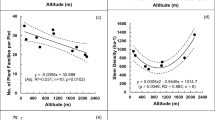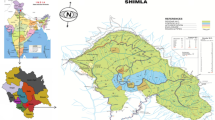Abstract
Tree species diversity of four tropical forest vegetation types was investigated in Xishuangbanna, southwestern China. These are: tropical seasonal rain forest, tropical montane rain forest, evergreen broad-leaved forest and monsoon forest over limestone. A total of 17 samples were taken and four species diversity indices were calculated: Shannon-Wiener's H′, the complement of Simpson's index, d′, Fisher's α and evenness index E. The results reveal the long-tailed rank/abundance diagrams of these forests. However, this feature is greatly reduced in the samples of monsoon forest over limestone. Tropical seasonal rain forest shows the highest tree species diversity of all four vegetation types. Owing to the variation of microenvironment, diversity values within the same vegetation type vary between the samples from different patches. The tree species diversity of single-dominant rain forest is not significantly lower than that of mixed rain forest, because the dominant species of some single-dominant rain forests are principally in the emergent layer. This is composed of sparse and huge trees of one species and, consequently, creates a unique canopy architecture and more heterogeneous microenvironments for the more diversified species composition under the emergent layer. The occurrence of tree species with small population sizes, particularly of species represented by only one individual, is highly correlated with the tree species diversity of the local forest vegetation. They are crucial elements in the richness of local biodiversity.
Similar content being viewed by others
References
Anderson, J.A.R. (1961) The destruction of Shorea albida forest by an unidentified insect. Emp. For. Rev. 40, 19–29.
Bailey, N.T.J. (1968) Statistical Methods in Biology. London: The English Universities Press LTD.
Beard, J.S. (1946) The Mora forest of Trinidad, British West Indies. J. Ecol. 33, 173–92.
Begon, M., Harper, J.L. and Townsend, C.R. (1990) Ecology: Individuals, Populations and Communities. London: Blackwell Scientific Publications.
Box, E.O., Fujiwara, K. and Qiu, X. (1991) Diversity and dissimilarity of three forest types in Xishuangbanna, tropical southern China. Bull. Inst. Environ. Sci. Technol. Yokohama Natn. Univ. 17, 85–105.
Connell, J.H. (1978) Diversity in tropical rain forests and coral reefs. Science 199, 1302–10.
Connell, J.H. and Lowman, M.D. (1989) Low-diversity tropical rain forests: some possible mechanisms for their existence. Am. Nat. 134, 88–119.
Denslow, J.S. (1987) Tropical rainforest gaps and tree species diversity. Ann. Rev. Ecol. Syst. 18, 431–51.
Deshmukh, I. (1986) Ecology and Tropical Biology. Palo Alto: Blackwell Scientific Publications.
Hart, T.B. (1990) Monospecific dominance in tropical rain forests. Trends in Ecology & Evolution 5, 6–11.
Hart, T.B., Hart, J.A. and Murphy, P.C. (1989) Monodominant and species-rich forests of the humid tropics: causes for their co-occurrence. Am. Nat. 133, 613–33.
Hubbell, S.P. and Foster, R.B. (1986) Biology, chance and history and the structure of tropical rain forest tree communities. In Community Ecology (J. Diamond and T.J. Case, eds) pp. 314–29. New York: Harper & Row, Publishers.
Itow, S. and Miyata, I. (1977) Species diversity of communities. In Composition and Structure of Plant Communities (S. Itow, ed.) pp. 76–111. Tokyo: Asakura.
Krebs, C.J. (1978) Ecology. New York: Harper & Row, Publishers.
Krebs, C.J. (1989) Ecological Methodology. New York: Harper & Row, Publishers.
Li, Y., Pei, S. and Zhao, S. (1984) List of Plants in Xishuangbanna. Kunming: Yunnan National Press. (In Chinese).
Magurran, A.E. (1988) Ecological Diversity and Its Measurement. Princeton: Princeton University Press.
Ovington, J.D. (ed.) (1983) Temperate Broad-Leaved Evergreen Forests. Amsterdam: Elsevier Science Publishers B.V.
Parker, R.E. (1976) Introductory Statistics for Biology. London: Edward Arnold.
Pianka, E.R. (1988) Evolutionary Ecology. New York: Harper & Row, Publishers.
Rai, S.N. and Proctor, J. (1986) Ecological studies on four rain forests in Karnataka, India. I. Environment, structure, floristics and biomass. J. Ecol. 74, 439–59.
Richards, P.W. (1952) The Tropical Rain Forest. Cambridge: Cambridge University Press.
Ricklefs, R.E. (1990) Ecology. New York: Freeman.
Swaine, M.D. and Hall, J.B. (1981) The monospecific tropical forest of the Ghanaian endemic tree Talbotiella gentii. In The Biological Aspects of Rare Plant Conservation (H. Synge, ed.) pp. 355–63. Chichester: John Wiley & Sons.
Walter, H. and Breckle, S.-W. (1991) Spezielle Ökologie der Gemáβigten und Arktischen Zonen auβerhalb Euro-Nordasiens. Stuttgart: Gustav Fischer Verlag.
Whitmore, T.C. (1984) Tropical Rain Forests of the Far East. Oxford: Clarendon Press.
Whitmore, T.C. (1990) Introduction to Tropical Rain Forests. Oxford: Clarendon Press.
Wu, Z. (1980) The Vegetation of China. Beijing: Science Press. (In Chinese).
Wu, Z., Zhu, Y. and Jiang, H. (1987) The Vegetation of Yunnan. Beijing: Science Press. (In Chinese).
Zhang, J. and Cao, M. (1995) Tropical forest vegetation of Xishuangbanna, SW China and its secondary changes, with special reference to some problems in local nature conservation. Biol. Conserv. 73, 229–38.
Author information
Authors and Affiliations
Rights and permissions
About this article
Cite this article
Cao, M., Zhang, J. Tree species diversity of tropical forest vegetation in Xishuangbanna, SW China. Biodiversity and Conservation 6, 995–1006 (1997). https://doi.org/10.1023/A:1018367630923
Issue Date:
DOI: https://doi.org/10.1023/A:1018367630923




